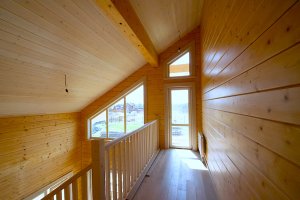 |
Timber imitation
Imitation of a bar is one of types of lining. Unlike the classic eurolining, the imitation of a bar does not have a recess on the front side (shelves).
Part number:
Supplier:
LLC "Luzales"Description
In addition, imitation boards are thicker and wider.
A wall or ceiling sheathed with imitation timber cannot be distinguished from a wall made of timber. It is for this external similarity that this wall panel got its name.
Imitation of timber is usually used for external and internal decoration of walls made of various materials: brick, blocks, solid wood, frame structures. In exterior decoration, a wider imitation of timber is usually used, this speeds up installation and gives solidity to the structure.
For interior decoration, a narrow imitation of timber (width 135-145 mm) is used. Such sheathing board allows you to visually increase the size of the room. In addition, ceilings are sheathed with imitation of timber.
Due to its large thickness, timber imitation has excellent sound-absorbing and heat-insulating properties. Properly dried and installed sheathing panel is very stable and is not subject to deformation and cracking. This compares favorably with timber, which, regardless of the quality of the material, will crack.
The imitation timber boards are usually laid horizontally with the spike up (so that moisture does not accumulate in the groove). But vertical laying is also possible, similar to the installation of eurolining. To fasten a narrow imitation of a beam, you can use clamps, staples or self-tapping screws screwed into the groove of the board. It is better to fasten a wide imitation of timber with self-tapping screws directly into the board layer, because. the board is quite massive and hidden fasteners may not withstand the stress of seasonal changes in temperature and humidity.
Even before installation, boards are coated with protective compounds, such as wax-based oils. Sometimes there is a temptation to cover an already finished surface, but this cannot be done, because. over time, unpainted stripes may appear between the timber imitation boards. The imitation boards are joined through a vertical bar so that the joint is not visible.
A wall or ceiling sheathed with imitation timber cannot be distinguished from a wall made of timber. It is for this external similarity that this wall panel got its name.
Imitation of timber is usually used for external and internal decoration of walls made of various materials: brick, blocks, solid wood, frame structures. In exterior decoration, a wider imitation of timber is usually used, this speeds up installation and gives solidity to the structure.
For interior decoration, a narrow imitation of timber (width 135-145 mm) is used. Such sheathing board allows you to visually increase the size of the room. In addition, ceilings are sheathed with imitation of timber.
Due to its large thickness, timber imitation has excellent sound-absorbing and heat-insulating properties. Properly dried and installed sheathing panel is very stable and is not subject to deformation and cracking. This compares favorably with timber, which, regardless of the quality of the material, will crack.
The imitation timber boards are usually laid horizontally with the spike up (so that moisture does not accumulate in the groove). But vertical laying is also possible, similar to the installation of eurolining. To fasten a narrow imitation of a beam, you can use clamps, staples or self-tapping screws screwed into the groove of the board. It is better to fasten a wide imitation of timber with self-tapping screws directly into the board layer, because. the board is quite massive and hidden fasteners may not withstand the stress of seasonal changes in temperature and humidity.
Even before installation, boards are coated with protective compounds, such as wax-based oils. Sometimes there is a temptation to cover an already finished surface, but this cannot be done, because. over time, unpainted stripes may appear between the timber imitation boards. The imitation boards are joined through a vertical bar so that the joint is not visible.